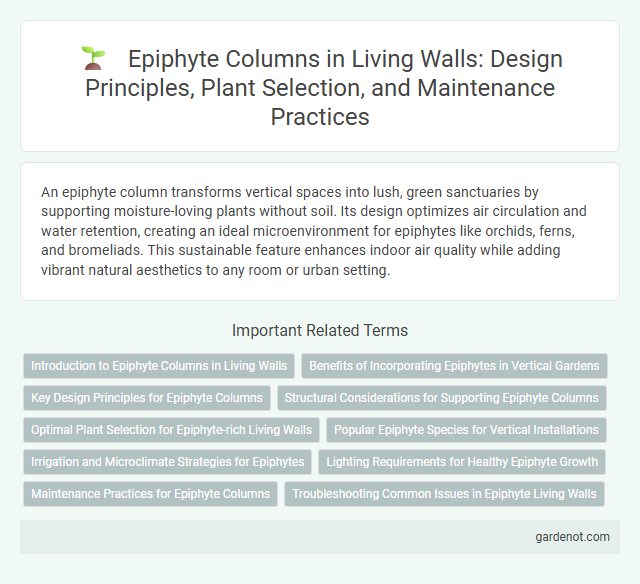An epiphyte column transforms vertical spaces into lush, green sanctuaries by supporting moisture-loving plants without soil. Its design optimizes air circulation and water retention, creating an ideal microenvironment for epiphytes like orchids, ferns, and bromeliads. This sustainable feature enhances indoor air quality while adding vibrant natural aesthetics to any room or urban setting.
Introduction to Epiphyte Columns in Living Walls
Epiphyte columns are vertical structures designed to support air plants that derive moisture and nutrients from the air, making them ideal for living walls. These columns enhance indoor air quality while providing a visually striking, low-maintenance green feature. Integrating epiphyte columns into living walls maximizes vertical garden space and adds biodiversity by accommodating unique plant species like orchids and bromeliads.
Benefits of Incorporating Epiphytes in Vertical Gardens
Incorporating epiphytes into vertical gardens enhances biodiversity by supporting diverse microhabitats and natural air filtration. Their unique ability to absorb moisture and nutrients from the air reduces watering needs and maintenance efforts. Epiphyte columns also improve indoor air quality and provide aesthetic appeal with lush, textured greenery in constrained urban spaces.
Key Design Principles for Epiphyte Columns
Epiphyte columns integrate vertical gardening with minimal soil, emphasizing lightweight structures and moisture retention materials to simulate natural habitats. Key design principles include selecting appropriate substrates that support epiphyte attachment and air circulation while ensuring efficient irrigation systems to maintain consistent humidity. Incorporating modular components allows easy maintenance and plant replacement, promoting healthy growth and aesthetic appeal.
Structural Considerations for Supporting Epiphyte Columns
Epiphyte columns require robust structural support designed to bear the weight of mature plants and retain moisture without compromising stability. Materials such as treated timber, lightweight metal frames, or reinforced concrete are commonly used to ensure durability and resistance to environmental stress. Proper anchoring systems and drainage integration help maintain the longevity and health of the living wall by preventing water accumulation and structural fatigue.
Optimal Plant Selection for Epiphyte-rich Living Walls
Selecting optimal plants for Epiphyte column living walls involves prioritizing species like Tillandsia, orchids, and bromeliads, which naturally thrive without soil by absorbing moisture and nutrients from the air. These epiphytes require environments with high humidity, good air circulation, and indirect light to flourish, making them ideal for vertical green installations. Proper selection enhances the living wall's aesthetic appeal, ecological function, and maintenance efficiency.
Popular Epiphyte Species for Vertical Installations
Philodendron, Anthurium, and Tillandsia are among the most popular epiphyte species for vertical living wall installations due to their adaptability and low maintenance requirements. These species thrive in well-ventilated spaces and require moderate indirect light, making them ideal for indoor vertical gardens. Their unique ability to absorb moisture and nutrients from the air ensures healthy growth without extensive soil, enhancing sustainability in living wall designs.
Irrigation and Microclimate Strategies for Epiphytes
Epiphyte columns utilize drip irrigation systems calibrated to maintain consistent moisture without waterlogging, essential for the delicate root structures of epiphytes. Microclimate strategies include optimizing air circulation and humidity levels through precise placement and use of misting systems, mimicking their natural rainforest habitats. This controlled environment supports epiphyte health by preventing fungal growth and encouraging nutrient absorption.
Lighting Requirements for Healthy Epiphyte Growth
Epiphyte columns require bright, indirect light to thrive, with natural sunlight being ideal to promote photosynthesis without causing leaf scorch. Maintaining consistent light exposure of approximately 12-14 hours daily supports healthy growth and vibrant foliage. Supplemental LED grow lights can effectively mimic natural light in low-light environments, ensuring the epiphytes' metabolic functions remain optimal.
Maintenance Practices for Epiphyte Columns
Maintenance practices for epiphyte columns include regular monitoring of moisture levels to prevent overwatering while ensuring sufficient humidity for optimal growth. Pruning dead or damaged leaves promotes healthy development and maintains aesthetic appeal. Periodic inspection for pests or fungal infections allows for early intervention, preserving plant vitality and structural integrity of the living wall.
Troubleshooting Common Issues in Epiphyte Living Walls
Epiphyte columns in living walls often face issues such as poor air circulation leading to mold growth and root rot, which can be mitigated by ensuring proper spacing and ventilation. Inconsistent watering practices cause dehydration or over-saturation; using moisture sensors helps maintain optimal hydration levels for epiphytes like orchids and bromeliads. Pest infestations, including scale insects and mealybugs, require regular inspection and organic treatments like neem oil to preserve plant health and aesthetic appeal.
Epiphyte column Infographic

 gardenot.com
gardenot.com